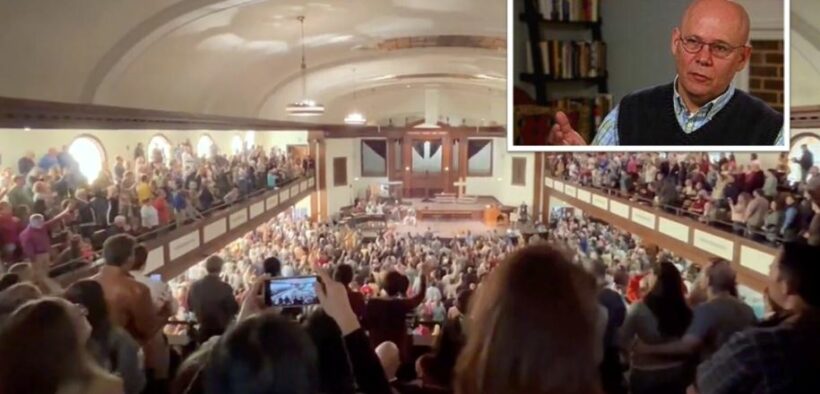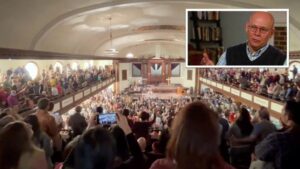EDITOR’S NOTEBOOK: Reflections on the Asbury Revival, and the Value of Old and Young Together

Editor’s Note: Most Saturdays we will feature this “Editor’s Notebook” column. MinistryWatch President Warren Smith will comment on one or more stories in the week’s news, adding an additional perspective or, sometimes, a behind-the-scenes look at how the story came to be.
The Asbury Revival. On the morning of February 8, a seemingly normal chapel service took place at Asbury University’s Hughes Auditorium. It included a message about confession and repentance.

After the service was over, a group of students stayed behind to continue worshiping. Then more joined them. And a few students “hanging out” after a chapel service turned into dozens, and then hundreds.
They continued to pray together throughout the day. By the end of the day, the word was spreading on social media and people from the small town of Wilmore, Ky., where the college is located, started joining in.
The students were reading scripture, praying, singing, and sharing personal testimonies.
Asbury Theological Seminary is also located there, and the seminary’s Vice President of Formation is Matt Barns. He said, “God began pouring out his love among the students in a profound way.”
The worship continued into a second day, and a third, and social media accounts have attracted people from thousands of miles away.
This is not the first time something like this has happened at Asbury University. The Asbury Revival of 1970 also took place in February that year after Dean Custer B. Reynolds invited students to share personal testimonies during the chapel service. What started was a revival that lasted for 144 hours. The chapel was filled with rejoicing people. Classes were canceled for a week. Even after classes resumed on February 10, Hughes Auditorium was left open for prayer and testimony.
Access to MinistryWatch content is free. However, we hope you will support our work with your prayers and financial gifts. To make a donation, click here.
What’s going on at Asbury now seems to be similar, but there are also some important differences.
Without taking anything away from what the Holy Spirit is doing in people’s lives, I think it is fair to say that social media is playing a big role. Hughes Auditorium holds about 1500 people. Another building that holds about 1000 people has also been opened, and people are standing in line to get into the buildings. The college and seminary combined have less than 2,000 students, so it’s obvious that people from outside the campus community are now coming to participate, and that’s been fueled by social media.
So am I saying that’s a bad thing?
No. Not at all. In fact, it may be that in God’s good providence He is using social media to spread the revival to other places. I’m just saying that it is undeniable that social media is playing a role.
It’s also important to note that one of the hallmarks of the 1970 Asbury Revival was that thousands of so-called “witnessing teams” went out from the college over the next couple of years to share their testimonies in churches. The lives of many of the students there were permanently changed. That could in fact be happening now, but it may be a while before we know.
That’s why as Christians we should welcome, even rejoice in, events such as what is happening at Asbury. There’s been a lot of criticism of the revival on-line, and I think that while I think it is appropriate to do what the Bible says, and that is to “test the spirits” and reserve judgment that this is a true revival – we should also hold back on the criticism. After all, as Christians we believe that God is at work in the world. Many of us have been praying for revival for years, even decades.
The real tragedy, in my view, would be not that this is a “fake revival.” I’ve covered a lot of so-called revivals over the years, and the fake ones collapse under their own weight eventually. No, in my view the real tragedy would be that it is a real revival and Christians failed to see it. I pray that future generations would not say of us: “He came to his own, and his own received him not.” (John 1:11)
By the way, if you want to read our coverage of the Asbury Revival, click here.
Don’t Hit The Panic Button. A survey distributed to messengers at the 2022 SBC Annual Meeting reveals that only 5 percent of respondents fell within the 18-29 age range. The highest percentage belonged to the over 60 age range, which represented more than 27 percent of the 1,000 survey participants.
You can read more facts and figures from this survey here. What I want to observe is that such data are not reasons to panic.
I’ve been seeing such surveys for year. David Kinnaman, the president of The Barna Group (who is also a friend and way smarter than me), wrote two books — unChristian and You Lost Me — with the premise that the church is losing young people.
I love and respect David. (Did I mention that he is way smarter than me?) I have quoted his work extensively over the years. Still, I worry that such data can be misappropriated, used out of context, to force innovations on the church that make us less orthodox and thereby less helpful to young people and all people – not to mention less faithful to God.
It’s worth noting a few things. First, the entire nation is getting older. The average age of an American today is 38.8. In 1970, the median age of an American was 27.1.
Secondly, few of these studies are longitudinal. A longitudinal study is research that involves repeated observations of the same characteristics or variables over time. So, for example, what would the 18-29 year-olds say when they are 48-59? We tend to panic when a 20-year-old doesn’t care as much about church as a 60-year-old, but maybe when he’s 60 he will. Maybe we’re not “losing a generation” after all. Maybe we just need take a deep breath and acknowledge that the 20-year-old will change over time.
In fact, what little data we have shows that shift does in fact take place. Take the Southern Baptist survey of messengers. The SBC has been asking those questions for 20 years, and the 2003 study shows that 5.62 percent of messengers were 18-29. About 24 percent were over 60. So, yes, there’s been some movement, but not much.
Also, let’s take a step back from the numbers and just think about this issue from both a biblical and a prudential point of view. Do we really want our large religious institutions run by people with no experience running large institutions? The Bible repeatedly extols the virtue of wisdom. Certainly young people can be wise, and old people can be foolish. But time and experience are great sifting and winnowing tools.
I think the right answer is that we need both the young and the old, together, in inter-generational communities. Young people bring the fire, and the older people can make sure the fire doesn’t burn the house down.
We need to be especially careful about innovations in the way we “do church” that might have unintended consequences. As humorist P.J. O’Rourke said, “Thinking outside the box is overrated. The best ideas are in the box. That’s why we put them there in the first place.”



